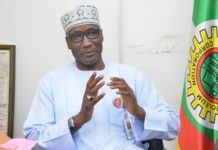National Cotton Association of Nigeria (NACOTAN) wants the Nigerian government to revamp the sector to reduce smuggling through the borders.
Their request comes just as the African Development Bank (AfDB) Group and other stakeholders brainstorm on the challenges facing the African textile industry and how to build the capacity of stakeholders to develop value chains.
The Trade Map of the International Trade Centre (ITC) shows that Nigeria exported cotton valued $4,789,000 in 2016, $5,598,000 in 2017, $7,037,000 in 2018 and $5,597,000 in 2020.
The decline is attributable to lack of supportive policy measures and critical infrastructure for the growth of the sector.
Largest Importers
Since 2016, Portugal has been the largest importer of cotton from Nigeria. It imported cotton worth $1,663, 000 in 2016, $810,000 in 2017, $1,764,000 in 2018, $1,742,000 in 2019 and $505,000 in 2020.
Pakistan did not import cotton in 2016 and 2017. However, it imported cotton valued $386,000 in 2018, $572,000 in 201 9 and $875,000 in 2020.
Vietnam did not import cotton from Nigeria in 2016, $149,000 worth of cotton in 2017, none in 2018, $369,000 in 2019 and $572,000 in 2020.
Cotton is a commercial crop grown mainly for its fibre or lint, and is commonly used in the textile industry.
Analysts say the performance of the industry has been in crises.
NACOTAN, as an association stressed the need for the government to eliminate multiple taxation on Cotton, Textiles and Garment (CTG) industries and products.
Basically, the believe this will encourage its members.
NACOTAN expressed this in a communiqué issued at the end of the first Nigeria International Cotton Summit and Expo 2023 signed by its President, Anibe Achimugu.
Also Read: ‘False And Malicious’: Emefiele Denies Fresh Plot Against Tinubu
They further called on the government at all levels to control the country’s borders by setting up anti-smuggling task forces at all points.
According to the communiqué, NACOTAN was urged to establish a working relationship through the Malian Ambassador in Nigeria with the Government of Mali by means of a Memorandum of Understanding (MoU), on cotton-farming best practices.
Rebranding Cotton Farming
“Since revamping the CTG Sector is predicated on the Public-Private Partnership, NACOTAN must expedite follow-up actions with the Federal Government, through the Federal Ministry of Industry Trade and Investment on resolutions of this Summit.
“NACOTAN must follow up promptly on the offer made by the Nigeria Export and Import (NEXIM) bank to allow cotton to benefit from their Bank’s financing intervention.
“It was agreed that NEXIM Bank will collaborate with already identified commercial banks to develop a model of financing that will be suitable for the CTG sector”.
According to the statement, “NACOTAN should follow up on the Indian High Commissioner’s offer of training and re-training on cotton farming.
“NACOTAN must ensure that cotton farming in Nigeria is ‘rebranded’ to become competitive and therefore attractive, especially to the teeming youths of our nation.
“NACOTAN must join the follow-up effort of the initiative to establish a bilateral agreement between Nigeria and India that allows both countries to pay for goods of trade with their respective currencies”.
Also, NACOTAN must follow up urgently on the offer made by NEPC to support cotton by reducing exportation costs using the instrument of the Export Expansion Grant (EEG).
“Federal and State governments must be made aware of the need and importance of support to Nigerian Cotton Farmers and Cotton Ginners.
“Government must do everything to revive the Textile and Garment Sub-sectors.
Anchor Borrowers Programme
“Cotton Farming must be provided with a High Volume Instrument (HVI) for rapid testing of important cotton quality parameters.
“The government must be made aware of the need to continue with the Anchor Borrowers Programme (ABP) in cotton farming, while NACOTAN commits to continue to pursue recoveries of loans given to farmers through the ABP,
“The sudden stoppage of the ABP after just two years created problems of continuity.
“NACOTAN must alert the Government/CBN of the need to ‘fine-tune the programme to run for at least five years in order that the full impact of the programme can be seen”, the communiqué read in part.
Have You Read: Naira Scarcity: Armed Robbers Operate With POS In Ibadan
According to analysts, increased investment cotton production would cater for the growing demand in the region for locally manufactured high quality clothes and leather products.
Textile Manufacturing Ecosystem
Cotton made in Africa (CmiA), an Aid by Trade Foundation (AbTF) initiative,said Nigeria, and nine other countries produced nearly 630,000 tonnes of sustainable cotton for the international market.
Also, there are about 1,000,000 smallholders in the 10 African countries.
These include Benin, Burkina Faso, Chad, Côte d’Ivoire, Cameroon, Mozambique, Nigeria, Tanzania, Uganda and Zambia.
CmiA works with small-scale farmers in Benin, Burkina Faso, Côte d’Ivoire, Cameroon, Chad and Nigeria as well as in Mozambique, Zambia, and Tanzania.
Furthermore, data by United Nations Conference on Trade and Development( UNCTAD) indicate that the cash crop generates income and welfare for over 250 million farmers across the globe.
Meanwhile, the African Development Bank Group’s country office in Benin held a workshop on the challenges facing the country’s textile industry and how to build the capacity of stakeholders to develop value chains.
The workshop drew fabric producers, dyers, stylists, designers, embroiderers, seamstresses, consumers, support function professionals, and value chain professionals, representatives of textile associations and government representatives.
The aim was to understand the needs and expectations of the textile manufacturing ecosystem and to incorporate local actors into value chains for mass-production of textiles.
“This workshop fits perfectly into the dynamics of structural reinforcement of the textile industry in Benin and the logic of consuming locally made products,” said Deputy Director of the Cabinet of the Ministry of lndustry and Trade, Dario Sacramento during the workshop. He said:
“This is a sector which offers many opportunities at all stages of the value chain. The project for the industrialisation of small-scale clothing in Benin, proposed by the African Development Bank, is part of the innovation movement with high added value for the Beninese consumer, which the government is trying to promote within the Beninese industry,” he added.
Development The Textile Industry
The African Development Bank Group’s Benin country manager, Robert Masumbuko, said, “the workshop is a step towards helping Beninese small and medium-sized enterprises to structure themselves and pool their efforts to support the dynamics set up by the Beninese authorities in favour of the development of the textile industry, through local mass production”.
Also, the private sector development is among the bank’s priority areas in Benin for the 2022 2026 period.
The aim is to support the transformation of agriculture and industrial development in the country.
“It is in the interest of all stakeholders in the Beninese garment industry that the textile sector be governed by international norms and standards so that production is attractive and meets the needs of local consumers as well as the increasingly pressing demand which comes not only from outside the country but also from outside the continent,” said Nadia Adanlé, founder of Couleur Indigo.
Also Read: Cubana Chief Priest Opens Up On Having Baby With Kenyan Lover
Couleur Indigo is an indigo dyeing company which employs a majority of people with disabilities. Adanlé is also a member of Benin’s Chamber of Crafts.
According to the government, the country’s textile industry has the potential to become one of the country’s major employers. The local market is expected to grow remarkably in the coming years.
Furthermore, in addition to collecting qualitative data from stakeholders on the needs of private and public operators, the workshop also provided an opportunity to propose an alternative to importation of lower quality clothing and textiles.
In addition to the mass production of textile products, the expectation is that the initiative should also lead to the implementation of a mutually beneficial production model that is accessible and financially profitable for local consumers while also satisfying demand for exports.





